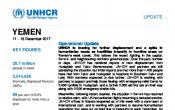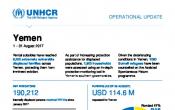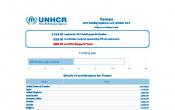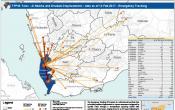Yemen
Operation: Yemen
Location
{"longitude":48,"latitude":16,"zoom_level":0}
Latest update of camps and office locations 21 Nov 2016. By clicking on the icons on the map, additional information is displayed.
Key Figures
| 2018 planning figures | |
| 610,000 | vulnerable IDPs/IDP returnees will receive cash grants for shelter and protection |
| 372,000 | IDPs/IDP returnees will receive core relief items |
| 23,000 | IDPs/IDP returnees will receive legal assistance |
| 50,000 | refugees willing to return to their country of origin will be supported with cash grants and protection counseling |
| 17,000 | of the most vulnerable refugees will receive cash grants |
| 14,000 | refugee children will be enrolled in primary education |
| 2016 year-end results | |
| 67,000 | internally displaced households (444,500 individuals) received core relief items |
| 22,000 | vulnerable internally displaced households (157,000 individuals) received shelter support |
| 9,000 | vulnerable refugee households were assisted, including assistance through cash grants |
| 6,000 | new refugees and asyulum-seekers were registered |
| 4,000 | refugees and 6,000 IDP houselholds received cash assistance |
Latest Updates and Related Links
People of Concern
17%
Increase in
2016
2016
| 2016 | 3,278,011 |
| 2015 | 2,809,088 |
| 2014 | 686,217 |

[["Refugees",269783],["Asylum-seekers",9097],["IDPs",2025060],["Returned IDPs",974058],["Returned refugees",1],["Others of concern",12]]
Loading ...
Yemen
< Back
2016
{"categories":[2013,2014,2015,2016,2017,2018],"budget":[73.02036891,55.90237687,107.42361363,124.06305842,113.6496478,198.743636538],"expenditure":[45.55776942,32.43507863,59.1504741,76.2339041,null,null]}
{"categories":[2013,2014,2015,2016,2017,2018],"p1":[34.65978173,37.76781567,54.5338847,48.97075377,63.273754,95.145668798],"p2":[null,null,null,null,null,null],"p3":[null,null,null,null,null,null],"p4":[38.36058718,18.1345612,52.88972893,75.09230465,50.3758938,103.59796774]}
{"categories":[2013,2014,2015,2016,2017,2018],"p1":[24.32612142,24.52485244,30.6292506,27.28466288,null,null],"p2":[null,null,null,null,null,null],"p3":[null,null,null,null,null,null],"p4":[21.231648,7.91022619,28.5212235,48.94924122,null,null]}
Loading ...
CHOOSE A YEAR
- 2014
- 2015
- 2016
- 2017
- 2018
Year-end Overview
Working environment
The humanitarian crisis in Yemen reached unprecedented levels during the first half of 2017, with no political solution in sight and an acute protection crisis sweeping the country. The conflict has left 20.7 million people, three quarters of the population, in need of humanitarian or protection assistance. Escalation of hostilities, disruption of basic services and destruction of infrastructure, compounded by severe economic deterioration, threat of famine, an outbreak of cholera, along with continued violations in international humanitarian law, has resulted in Yemen becoming the largest humanitarian crisis in the world. As of July, close to two million people, across 21 governorates, were forced to flee their homes, with 84 per cent of them displaced for more than a year. A further 946,000 internally displaced people (IDP) returned to their location of origin, 88 per cent of whom returned more than one year ago. Despite this trend, many returns took place under hazardous circumstances and conditions in places of return remained complex.
As of August 2017, the refugee and asylum-seeker population stood at some 280,600 people, all of whom continue to live in precarious situations. Despite war, an estimated 60,000 refugees and migrants arrived or transited through Yemen in 2017. Coupled with continuous economic decline and a chronic lack of livelihood opportunities, vulnerabilities of people of concern have been exponentially amplifying. Insecurity and ongoing hostilities continue to hamper provision of assistance and limit the protection space. Given these deteriorating conditions for refugees in Yemen, UNHCR in partnership with IOM, will continue to support Somali refugees wishing to return to Somalia.
UNHCR partners with a number of national and international non-governmental organizations, as well as UN agencies, such as UNICEF, WFP and WHO, in order to deliver more comprehensive services to displaced populations. UNHCR leads the Protection, Shelter/Non-Food Items/ and Camp Coordination and Camp Management clusters. In addition, UNHCR works with key line Ministries to expand and enhance local response capacities, with the aim of mainstreaming health and education services for refugees into existing national systems.
Assessments conducted by the clusters have identified health, food and nutrition, and the protection of civilians as the most critical needs of the IDPs. Additional findings have identified separated families, limited freedom of movement, lack of civil documentation, arbitrary arrest and detention, harassment, limited access to services, conflict-related injuries, acute mental distress, child recruitment, gender-based violence, high cost of living and lack of livelihood opportunities as some of the main challenges faced by IDPs.
Key priorities
In 2018, UNHCR will focus on:
- Providing lifesaving support and legal protection to refugees, asylum seekers, IDPs and IDP returnees;
- Increasing the scope of cash-based interventions for refugees, IDPs and IDP returnees as the most effective tool to deliver assistance;
- Jointly with the Yemen authorities, ensuring the provision of international protection to refugees arriving and residing in Yemen, in accordance with the 1951 Refugee Convention and its 1967 Protocol to which Yemen is a signatory;
- Advocating for and supporting diverse durable solutions for all people of concern including voluntary return, local integration, and other alternative pathways in support of comprehensive solutions;
- Under the Assisted Spontaneous Return (ASR) programme, providing assistance to Somali refugees who wish to return to Somalia;
- Widening the scope of an information campaign, to highlight the risks associated with irregular movements across the seas from the Horn of Africa to and through Yemen ;
- Strengthening protection interventions for returnees and IDPs, particularly through community-based protection networks, to provide legal assistance and psychosocial support with a focus on sexual and gender-based violence survivors;
- Increasing the level of partnerships with all humanitarian actors in Yemen with the aim of enhancing coordination mechanisms;
- Strengthening the capacity of local partners and diversify partnerships in order to provide effective, efficient and tailor-made interventions for refugees and IDPs.





